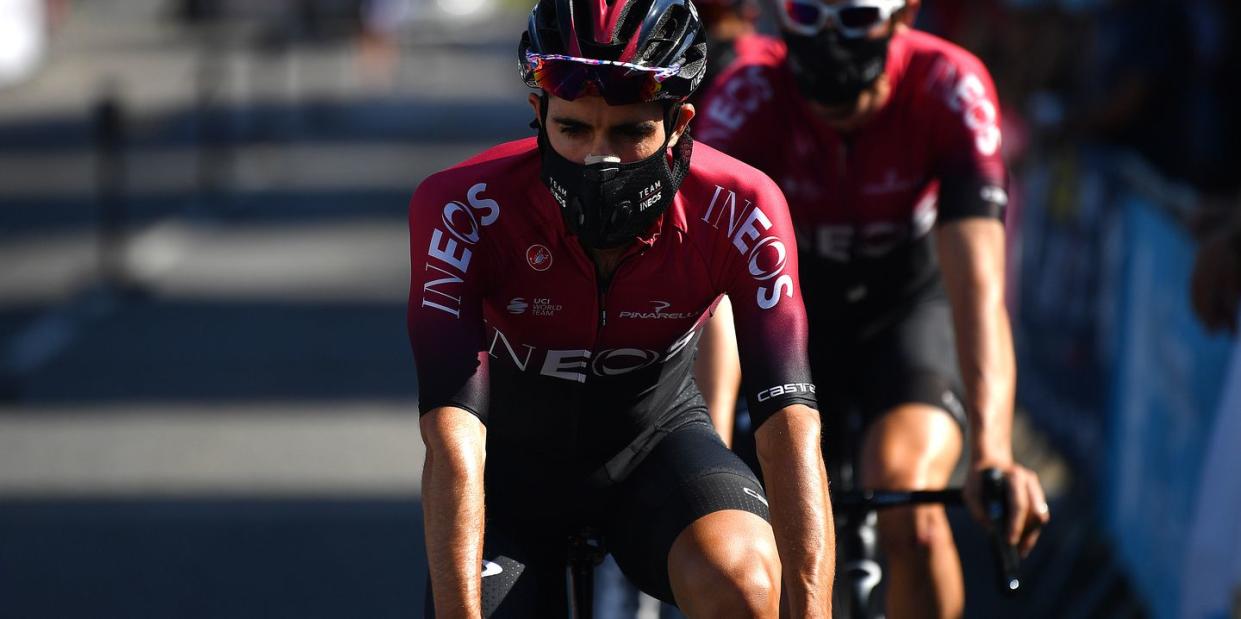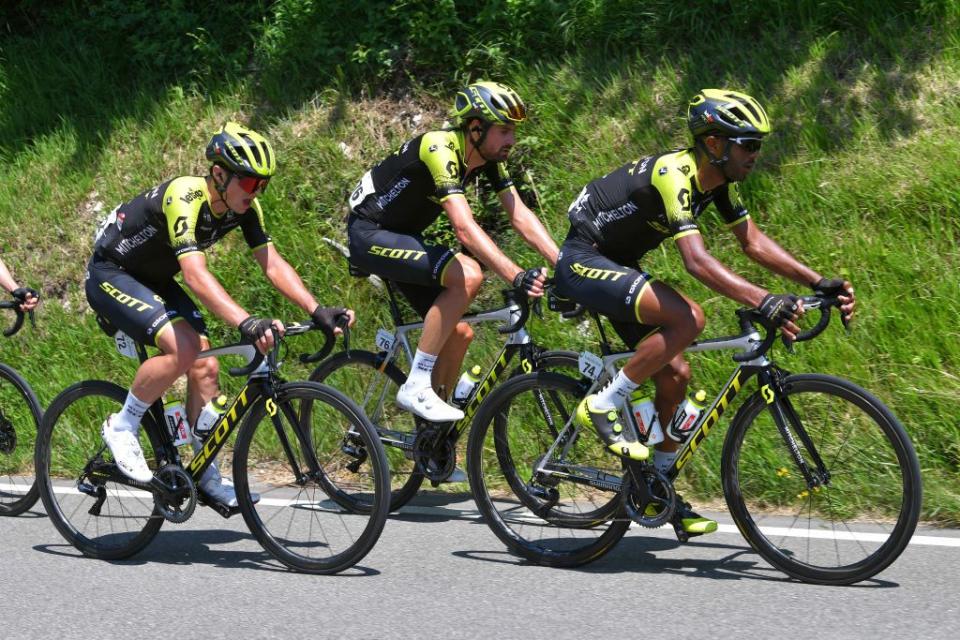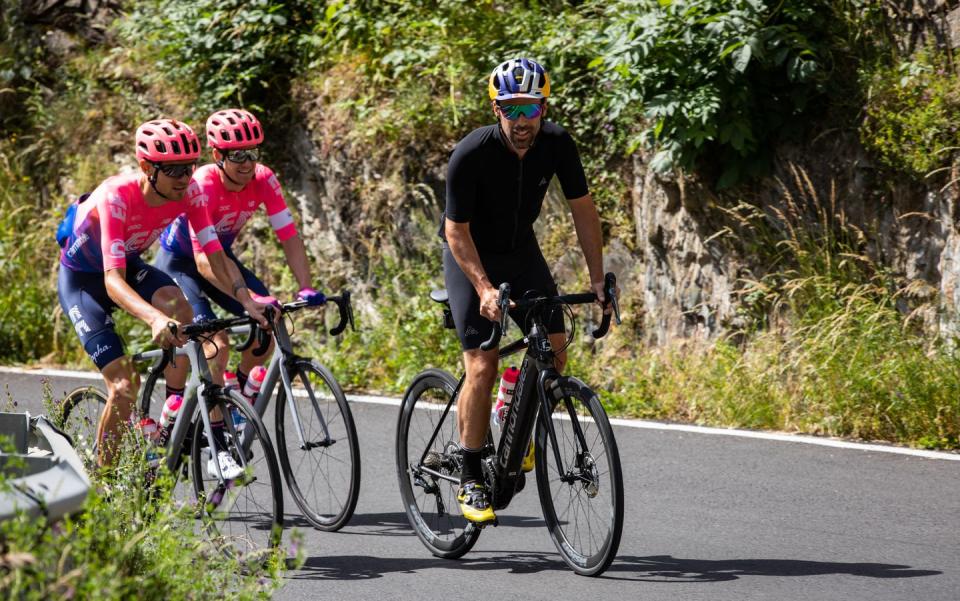Racing the Tour de France is Absolutely Brutal. Here’s How the Pros Prepare

The Tour de France is the crown jewel of the WorldTour calendar. Over the course of three weeks, all eyes are on professional cycling’s best riders as they push their bodies to the limit for more than 2,000 miles. It’s a race that demands respect, inspires awe, and requires an unbelievable amount of prep work—by teams and the individual riders.
“The team can only have a goal or execute on a strategy if each athlete they bring to the Tour is as fit as they possibly can be with the most positive attitude,” says exercise physiologist Allen Lim, Ph.D., who has coached several WorldTour riders including Tejay van Garderen of EF Education First. “This means that in order for an athlete to be truly selfless at the Tour for their team, they must be very selfish in their training and preparation.”
From a team perspective, that preparation happens almost as soon as the prior year’s Tour is over. “We start working on the Tour de France plan and selection at the end of September,” says Aike Visbeek, Team Sunweb’s former Tour de France coach. “We make an outline of how we want to set up the season, and then later on in October or November when the route is announced, we fine-tune the selection and our plans.”
The entire year is then mapped out, race-by-race for each rider based on what the rider’s role, responsibilities, and capabilities are. It’s then up to their personal coach to devise a training plan that prepares them to “peak” or perform optimally at two, three, maybe four goal races the following year—including the Tour de France.
“Peaking for a three-week race is really hard,” says Lim. “Every athlete, depending on their own past experience, goals, and physiology takes a different approach. There’s no one-size-fits-all protocol. It’s as much science as it is art.”
However, this year pro cyclists have been forced to take a different approach to their Tour de France training due to the coronavirus pandemic. With that said, here’s a high-level overview of what’s involved in preparing for one of the most physically grueling events in the world—both during a typical year and this year.

7 Months Out: Build a Base
Most riders start easing back into training mid-November or early December. “December is generally a fairly big volume-building month, as is January,” says Ben Day, Mitchelton-Scott Cycling Team’s high-performance coach. “A standard ‘work week’ would be anywhere from 20 hours to 31 hours. So they spend a lot of time out there on the bike, but we keep the intensity low. The focus is on creating aerobic proficiency and reinforcing the body’s ability to burn fat as fuel.”
Because the demands on WorldTour riders are so great in terms of race length, Day finds that putting a lot of emphasis on building a strong aerobic foundation early in the season makes athletes more resilient and better able to maintain their form. “You can predict their peak quite a lot better,” says Day, “And then when they do peak, they don’t lose it as quickly.”
In addition to developing an aerobic base, many riders will also incorporate strength and flexibility work into their training schedule two to three times a week.
“We try and do this year-round,” says Lim. “Unless you have a routine you can do throughout the year, it’s not worth doing a short block in the off-season and not doing it in-season. So we rely mostly on bodyweight exercise, physical therapy routines to help with muscle imbalances, core work, yoga, stretching, and body work.”
5 Months Out: Crank Up the Intensity
If riders weren’t racing in January, their training starts firing on all cylinders in February and March as racing begins in earnest. “We’ll step up the intensity to a slightly higher level, with a bit more tempo, sub-threshold, and threshold work,” says Day.
Think of threshold as the hardest effort you can sustain for an hour. “We want to build up a lot of fitness below that level,” says Day. “Once we start working above that level, we’re now working on very specific race intensities. We don’t dive into those for too long because we need to keep some bullets for the races.”
That’s especially important because potential Tour riders will be racing longer stage races that last six to 10 days. “Sometimes, we train right into a stage race to better simulate what a grand tour might look like, or we’ll continue training after that race,” says Lim. “It all depends on how the rider feels and on whether or not they’re still healthy and strong enough to handle the training load.”
As racing begins, riders will also use this time to dial in their nutrition on and off the bike. “Riders who are participating in the Tour de France peak with their body weight like they do with their training sessions,” says Stephanie Scheirlynck, dietitian for Team Trek-Segafredo. “It’s about finding a balance between getting them fit in time but not negatively affecting their training. It’s something that we are working on weeks and months before the Tour.”
3 Months Out: Shift to Race-Specific Training
Starting around April, riders move into more of a race-specific training phase, during which they’re no longer building aerobic fitness so much as managing fatigue and high-intensity efforts. Any strength work that they were doing goes into more of a maintenance phase. The focus during this training block is on getting results and preparing for the Tour.
“Most riders peak at least once before the Tour, whether it’s in April for the Ardennes Classics or the Giro D’Italia in May,” says Day. “They have one peak early on, then there’s a little bit of recovery phase before we move into that next phase of Tour de France preparation.”
Using races as training is a necessity when preparing for a race like the Tour. “It’s such a monster that you will never complete that task in preparation in any kind of simulated way before it,” says Neal Henderson, who has coached Rohan Dennis of Team Ineos, since 2013. “You will never put in a training load that’s bigger than any of the race weeks and especially not three of them in a row.”
In addition to races, one of the ways teams build in additional training blocks is through team camps. “They’re typically between five and 10 days,” says Henderson. And these days, things are much more structured than they used to be.
“Six, seven years ago, a lot of the training camps were a little bit looser,” says Henderson. “Now you know the training schedule for the day and what the expectations are. And the support from the team and staff is greater. The role of these camps has definitely increased in the past few years.”
Day agrees. By his estimate, out of the 12 months of the year, Mitchelton-Scott Cycling holds around eight mini camps. “It means fewer race days, but more specific control of our riders training and preparation.”

Altitude training often plays a part at these camps, as does team time trial training. At an EF Education First Pro Cycling team camp Lim organized last year in Andorra, retired professional cyclist Tim Johnson paced riders preparing for the Tour (including EF’s Tejay van Garderen, Mike Woods, Simon Clarke, and CCC’s Joey Rosskopf) by riding an e-bike to create real race simulations in the mountains. “It was a way to specifically simulate what it’s like to be drug up the steepest and hardest climbs of the Tour by Team Ineos,” says Lim.
How each rider approaches a training camp depends on his role on the team and his specialty. For example, a climber would opt to spend more time in the mountains doing lots of long, steady climbs, while the rest of his team might choose a different destination to work on high-intensity speedwork.
[Want to fly up hills? Climb! gives you the workouts and mental strategies to conquer your nearest peak.]
Regardless of whether riders are racing right up until the Tour or attending a team camp, the biggest peak of their training will typically occur anywhere from three to six weeks prior to the start of the Tour. “Generally there is a recovery after that,” says Henderson “And then just a little bit of a kind of taper or sharpening going into the race.”
But this year, there were hardly any races for training. As spring races were being canceled due to coronavirus concerns, the Union Cycliste Internationale (UCI) finally announced on April 15 that all WorldTour events were suspended until August 1. That turned the usual training timeline on its head and left teams facing months of uncertainty.
“Now you don’t have a specific date you’re working for, so that was really hard,” says Peter Schep, head of performance for EF Education First. “Even if they’ve done some races, there’s a lack of racing compared to the normal approach.” Once the UCI unveiled the revised race calendar, teams were still left with deciding how to best train their riders without months of racing and with little ability to hold standard training camps because of health concerns.
“In early April, May, June we worked on 10- to 20-minute efforts because that’s still the endurance period,” Schep says. He also focused on finding individualized ways to challenge his team, while keeping the training enjoyable during such a difficult time.
“We have been trying to challenge them in different ways, depending on how they feel about it themselves,” Schep says. “Now I gave them way more freedom… More freedom to get them fresh in mind and try to enjoy cycling. During coronavirus you need to enjoy cycling in a different way.” Without anyone to compete against (except virtually), he had riders focus on beating their personal bests, with some using Training Peaks to do so.
Once coronavirus restrictions began to lift in different parts of the world, EF Education First organized small, personalized training camps for those who live near each other. They emphasized hard, hilly rides as a replacement for the intensity of racing, which also tied in training at altitude. They’ve also focused on adapting to riding in the heat. From July onward, Schep says they began stricter training to get back into race rhythm again.
Though he thinks they’ve managed well so far, Schep says it’s still been “really difficult.” Typically, the Tour de France would take place during a WorldTour cyclist’s “second cycle” of racing in the season. This year, the Tour is happening during the riders’ first cycle.
1 Week Out: Taper
In general, most riders will have completed their last long ride the weekend before the Tour, and then they start to dial it back by tapering.

“They go from riding five to six hours a day to riding about an hour or so or just taking the whole day off,” says Lim. “That said, the week before that, we’re already shortening the training blocks to only two or three days with ample rest in between. So in some ways, the taper is really starting two weeks out despite the fact that on the hard days of training, the training is really hard.”
The week of the Tour, they might do a short speed workout on Tuesday or Wednesday behind a scooter. “That sort of simulates what it feels like to be in the pack,” says Day. “So like a little burst of power and really picking up the pedaling cadence as well. It’s important that we keep the body activated and open and everything functioning well without adding any fatigue into the system. So the sessions will be shorter, but we’ll still keep some intensity in there.”
Later in the week, the riders may have a team time trial session. “They’ll get out there, and they’ll ride two to three hours on the time trial bikes,” says Day. “Make sure everything’s dialed in and do some hard efforts at race pace.”
On Friday, some will do 60 to 90 minutes of active recovery with some openers—two- to five- minute efforts during which the riders progressively pick up the intensity—or a couple of sprints.
This year, cyclists are going into the Tour de France with only a few weeks of racing under their belt since the season restarted on August 1. But as in a normal year, Schep says his team will focus mostly on recovery the week before the Tour. They’ll also do some Tour-specific training, including a time trial session.
And then the race starts on Saturday, and you hope everything comes together. But there are no guarantees.
“There’s no right way to do this,” says Lim. “Every person and every situation is different. When training for a grand tour, the best-case scenario never happens. But bad luck creates opportunity—that’s what the Tour de France is all about.”
And Then There’s La Course

The men aren’t the only riders training all year to race at the Tour, but you wouldn’t know it looking at the schedule. La Course by Tour de France, the women’s stage of the Tour, is back for another year but still only as a one-day race. What’s worse, in a normal year it takes place immediately after one of the most important races on the women’s calendar, the Giro Rosa, severely limiting teams’ ability to prioritize it.
“La Course is obviously a very important race for us because it’s organized by the ASO, it runs parallel to the Tour, and it has the widest reach among media analyzers,” says Ronny Lauke, team manager and sports director for Canyon-SRAM Racing. “But it’s also only four days after Giro Rosa. Both are highlights, so we try to peak for Giro and then the idea is basically to carry the strength and form from Giro to La Course and perform there as well at the highest level.”
Day, who also coaches Ruth Winder, last year’s U.S. women’s road race national champion, agrees. “I wouldn't say there are too many people that peak solely for La Course versus Giro Rosa. A lot of riders focus on nationals, Giro Rosa, and then La Course takes care of itself.”
“It’s basically recover and reload the best you can and then go at it,” says Henderson, who coached Evelyn Stevens to her 2016 Giro Rosa stage win.
It’s not ideal, but it’s doable. “The riders build up so much fatigue throughout the year, they’re pretty used to racing under that sort of a load,” says Day. “It’s only if somebody really finishes the Giro Rosa on their knees or maybe like a little bit sick or something like that, that they wouldn’t recover in that four day period.”
This year, the coronavirus pandemic has also flipped women’s pro cycling on its head: La Course will instead take place before the Giro Rosa.
You Might Also Like

